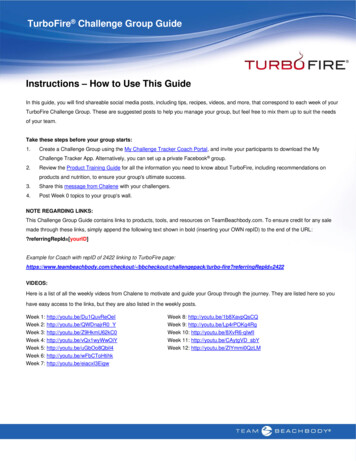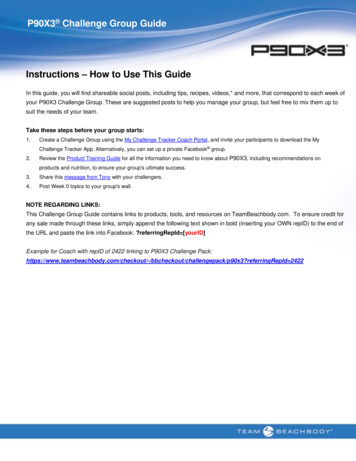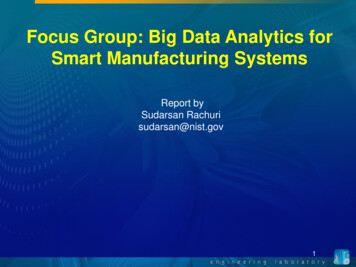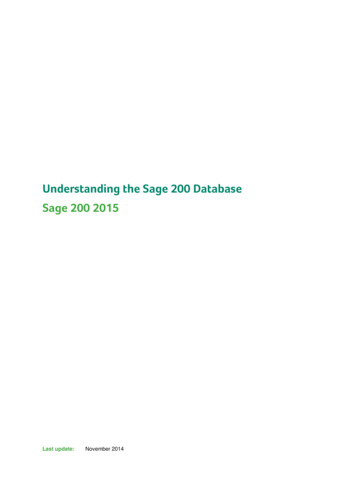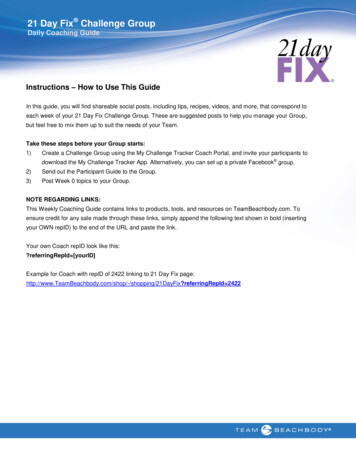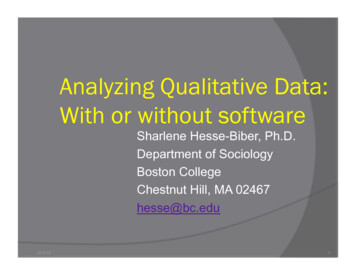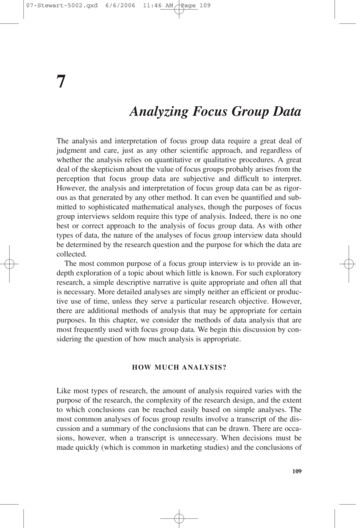
Transcription
07-Stewart-5002.qxd6/6/200611:46 AMPage 1097Analyzing Focus Group DataThe analysis and interpretation of focus group data require a great deal ofjudgment and care, just as any other scientific approach, and regardless ofwhether the analysis relies on quantitative or qualitative procedures. A greatdeal of the skepticism about the value of focus groups probably arises from theperception that focus group data are subjective and difficult to interpret.However, the analysis and interpretation of focus group data can be as rigorous as that generated by any other method. It can even be quantified and submitted to sophisticated mathematical analyses, though the purposes of focusgroup interviews seldom require this type of analysis. Indeed, there is no onebest or correct approach to the analysis of focus group data. As with othertypes of data, the nature of the analyses of focus group interview data shouldbe determined by the research question and the purpose for which the data arecollected.The most common purpose of a focus group interview is to provide an indepth exploration of a topic about which little is known. For such exploratoryresearch, a simple descriptive narrative is quite appropriate and often all thatis necessary. More detailed analyses are simply neither an efficient or productive use of time, unless they serve a particular research objective. However,there are additional methods of analysis that may be appropriate for certainpurposes. In this chapter, we consider the methods of data analysis that aremost frequently used with focus group data. We begin this discussion by considering the question of how much analysis is appropriate.HOW MUCH ANALYSIS?Like most types of research, the amount of analysis required varies with thepurpose of the research, the complexity of the research design, and the extentto which conclusions can be reached easily based on simple analyses. Themost common analyses of focus group results involve a transcript of the discussion and a summary of the conclusions that can be drawn. There are occasions, however, when a transcript is unnecessary. When decisions must bemade quickly (which is common in marketing studies) and the conclusions of109
07-Stewart-5002.qxd6/6/200611:46 AMPage 110110FOCUS GROUPSthe research are rather straightforward, a brief summary may be all that isnecessary. In some cases, there may be time or budget constraints that preventmore detailed analysis. In other cases, all interested parties and decision makersmay be able to observe or participate in the group, so there may be little needfor a detailed analysis or report. Nevertheless, some type of report is almostalways helpful, if only to document what was done for historical and auditingpurposes.When the results of a focus group are so obvious as to require little supporting documentation, detailed analysis is probably not worthwhile. One ofthe authors was involved in a series of focus groups on a new government program that was so clearly unacceptable and elicited so many objections that further analysis of any kind seemed unwarranted. In this case, the decision aboutthe program was made quite clear by the focus group discussions. This is, infact, a good example of how useful focus groups can be as evaluative tools. Itis often the case that government planners, product design engineers, and otherprofessionals who design products and services believe that they understandwhat their clients or customers need or should want. Focus groups provide atool for testing the reality of assumptions that go into the design of services,programs, and products. On the other hand, if the researchers in this examplewere interested in more than making a simple go/no go decision about a product or program and instead wished to explore in detail the reasons the programwas unacceptable and the types of programs that might be acceptable, moredetailed analyses would be needed. Thus, the amount of analysis and the levelof detail and rigor ultimately depend on the purpose for which the research iscarried out and the cost-benefit of carrying out an analysis at a given level.Aside from the few occasions when only a short summary of focus groupdiscussions is required, all analytic techniques for focus group data requiretranscription of the interview as a first step. Thus we consider the issues surrounding the transcription process and then turn our attention to some of themore common tools for analysis of focus group data.TRANSCRIBING THE INTERVIEWThe first step in many approaches to the analysis of focus group data is to havethe entire interview transcribed. Transcription services are readily available inmost cities and are generally able to provide relatively rapid turnaround atmodest cost. Transcription not only facilitates further analysis, but also it establishes a permanent written record of the group discussion that can be shared withother interested parties. On the other hand, in research situations that are time
07-Stewart-5002.qxd6/6/200611:46 AMANALYZING FOCUS GROUP DATAPage 111111pressured or involve fairly mundane issues (e.g., advertising copy testing), atranscript may not be prepared. In these cases, the researchers rely on detailednotes taken by the focus group observers, or they may also replay the audioor videotape of the group as needed.The amount of editing that the analyst does on a transcribed interview is amatter of preference. Transcriptions are not always complete, and the moderator may want to fill in gaps and missing words, as well as correct spelling andtypographical errors. There is a danger in this, of course, because the moderator’s memory may be fallible or knowledge of what was said later in the courseof the interview may color the memory of what happened earlier.Transcription also will faithfully pick up incomplete sentences, half-finished thoughts, parts of words, odd phrases, and other characteristics of thespoken word in a group discussion. These characteristics are true to the flowof the discussion, but they may make it difficult for a reader to follow the text.Some editing may increase readability, but it is important that the character ofthe respondents’ comments be maintained, even if at times they use poor grammar or appear to be confused. Because one use of focus group interviewing isto learn how respondents’ think and talk about a particular issue, too muchediting and cleaning of the transcript is undesirable and counterproductive.Once the transcript is finished, it can serve as the basis for further analysis. Itshould be noted, however, that the transcript does not reflect the entire characterof the discussion. Nonverbal communication, gestures, and behavioral responsesare not reflected in a transcript. In addition, the way members of the group usewords and the tone with which words are used are important sources of information and can radically alter the interpretation of a statement. The statement,“That is bad,” can have several very different meanings. The word bad is sometimes used as a way to say something is actually very good. Such a statementcould also mean something is really bad in the traditional meaning of this word.For these reasons, the interviewer or observer may wish to supplement thetranscript with some additional observational data that were obtained duringthe interview. Such data may include notes that the interviewer or observersmade during the interview, the systematic recording of specific events andbehaviors by trained observers, or the content analysis of videotapes of the discussion. Such observational data may be quite useful, but it will only be available if its collection was planned in advance. Preplanning of the analyses ofthe data to be obtained from focus groups is as important as it is for any othertype of research. Once the focus group discussions have been transcribed,analysis can begin. Today researchers have a variety of choices in analyzingfocus group data, and these generally fall into two basic categories: qualitativeor quantitative. Because focus groups are a variety of qualitative research, thefollowing discussion examines qualitative analytic approaches.
07-Stewart-5002.qxd6/6/200611:46 AM112Page 112FOCUS GROUPSQUALITATIVE ANALYTIC APPROACHESTechnological advances in statistics have enabled extensive and elaborateanalyses of huge data bases derived from surveys, retail transactions, censusdata, and numerous other sources. As later sections in this chapter explain,quantitative analyses can also be applied effectively to qualitative data obtainedfrom individual depth interviews, focus groups, and ethnographies. On theother hand, studies that rely on qualitative research methods often employqualitative approaches to extracting meaning from the data. Unfortunately,unlike most statistical paradigms, there is much less consensus on how to analyze and interpret qualitative data. To a considerable degree, this is the resultof differences in the epistemological orientations and phenomenological focithat characterize the behavioral science disciplines.Epistemological OrientationWhether explicit or simply subsumed, disciplines adopt basic premisesabout the sources and nature of knowledge. Three distinctive perspectives areparticularly relevant to qualitative analyses of focus group data (Sayre, 2001).First, social constructivism broadly posits that much of reality and the meaning and categories that frame everyday life are essentially social creations.This orientation traces its origins to thinking from social psychology, sociology, and cultural anthropology. Focus group analyses that reflect this viewtend to emphasize how group members collaborate on some issue, how theyachieve consensus (or fail to), and how they construct shared meanings aboutcommercial products, communications, or social concerns. The phenomenological approach to analysis is almost the opposite. Drawing generally fromclinical psychology and more specifically from phenomenological psychology, the analytic emphasis is on the subjective, idiosyncratic perceptions andmotivations of the individual respondent. This perspective is particularly useful in marketing focus groups in which managers are extremely interested, forexample, in the detailed and in-depth reasons why one person loves the newflavor of Fritos and another group member finds it disgusting. Because bothindividuals represent important segments, thoroughly mining their thoughtsand feelings is critical. Finally, advocates of interpretivism accept the priorperspectives but are skeptical about taking focus group respondents’ words atface value. Researchers from this school owe much to ethnographic studiesthat focus on both individuals’ words and actions, particularly to the science ofbody language and facial expressions.
07-Stewart-5002.qxd6/6/200611:46 AMANALYZING FOCUS GROUP DATAPage 113113Disciplinary FocusAs discussed in Chapter 1, the ways in which the earliest focus groups weredesigned, fielded, and analyzed were strongly influenced by their parent disciplines, particularly social and clinical psychology and marketing research. Theseinfluences remain strong today, although much cross-disciplinary evolution hasblurred some of the original differences. Newer intellectual currents have alsoaffected how researchers analyze focus group data. The field of hermeneuticsmigrated from Europe to the American consumer research community in the1980s. It values consumer stories, or narratives, as a powerful tool for understanding consumer motivation, meaning, and decision making. Consumers’ verbal expressions are conceptualized as “text” and interpreted through an iterativeprocess of reading, analyzing, and rereading the text. For a review of the hermeneutic approach, see Thompson (1997). The field of semiotics also focuses ontextual data but interprets this more broadly as including not only verbal expressions but pictures, sounds, products, and advertisements (Sayre, 2001, p. 210).Semiotic analyses commonly deconstruct textual data to uncover unintended orhidden messages, which has proved particularly useful in the field of advertisingand communications research (McQuarrie & Mick, 1996; Stern, 1995). Morebroadly, semiotic analyses of qualitative consumer data have helped identify thesigns and symbols that are embedded in textual data (Umiker-Sebeok, 1987).Finally, some approaches to analyzing focus group data are, in comparison withhermeneutics and semiotics, relatively atheoretical. This is particularly true ofmarketing studies that seek to discover the major ideas and themes that emergefrom the group discussion. This approach also serves marketers’ frequent needto quantify, statistically analyze, and generalize the findings from small-samplequalitative studies.Workbench IssuesRegardless of the disciplinary orientation of the focus group researcher,there are common everyday issues that arise during many groups and requireanalytic attention. Unlike statistical studies, focus group analysis actuallybegins once the group has begun. This is due largely to the discretionaryopportunities the moderator has to terminate a topic, expand the discussion onone that the group finds involving, or introduce an entirely new line of questioning. Still, the main analytic work occurs after the focus group discussionends. Above and beyond the hard data provided by the transcript, qualitativeanalyses of focus groups involve other often equally important considerations.
07-Stewart-5002.qxd6/6/200611:46 AM114Page 114FOCUS GROUPSThe following draws from discussion in A. E. Goldman and McDonald (1987,pp. 164–166).Issue OrderFocus group discussions commonly begin with open-ended “grand tour”questions that seek to obtain participants’ overall orientation toward a topic. Themoderator might begin with questions like, “Tell me about your overall groceryshopping experiences these days,” or “How do you feel about your health insurance plan?” It is often analytically inter
Analyzing Focus Group Data The analysis and interpretation of focus group data require a great deal of judgment and care, just as any other scientific approach, and regardless of whether the analysis relies on quantitative or qualitative procedures. A great deal of the skepticism about the value of focus groups probably arises from the perception that focus group data are subjective and .


